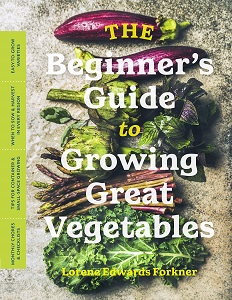
Not just for beginners, Lorene Edwards Forkner’s latest vegetable gardening book is chock full of good advice for all gardeners. If you are a beginner, I suggest reading the opening chapter, “Gardening 101.” For everyone, the chapter entitled “Garden Planning” will help you decide what type and especially how much food growing is realistic for you, including options if you do not have garden space. Like ornamental plants? These are encouraged for edible fruits or flowers, or to attract beneficial insects to protect or pollinate your food crops.The book’s core is a month-by-month calendar showing both the planning and the doing for the time of year, including seasonal essays. For example, September is the time to plan for your fall and winter garden, planting cover crops and saving seeds. October is about cleaning and feeding the garden for the future, especially after the first frost, and creating or enhancing your process for making home compost.Forkner encourages experimentation and keeping a journal of the results. She happily shares her personal experiences, good and bad. “Over the years I’ve experimented with sowing ornamental corn, winter wheat, and fancy French melons. Ultimately, I decided that homegrown popping corn is highly overrated, and my cat took up napping in the middle of my ‘wheat field.'” She concludes that the two tiny Charentais melons her efforts produced “were absolutely delicious–well worth the time and garden space they occupied all summer.”While similar in some ways to her 2012 publication The Timber Press Guide to Vegetable Gardening in the Pacific Northwest, this book incorporates nine more years of Forkner’s experience. Check it out!
Reviewed by Brian Thompson for the Leaflet for Scholars, August 2022, Volume 9, Issue 8.Editor’s note: A longer version of Brian’s review was originally published in the Autumn 2021 issue of Northwest Horticultural Society’s Garden Notes.